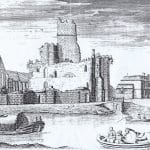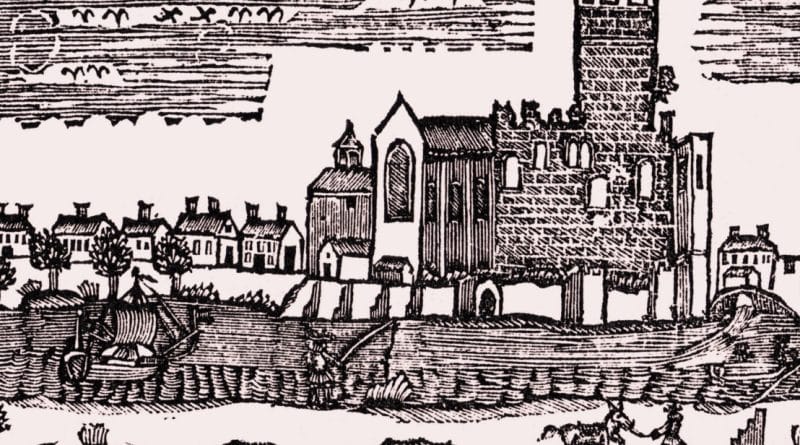Cawood Castle – The ‘Windsor of the North’
Cawood Castle is sometimes referred to as being ‘The Windsor of the North’. Built for the Archbishops of York, Cawood is perhaps better described as a Palace, though it could be, and was, used as a military base. In the 15th century Cawood was a primary residence of John Kemp, Archbishop of York. Kemp made extensions and improvements to the earlier castle. As a result, Cawood became palatial in design and saw many Royals and senior nobles as guests.
Origins
In the tenth century a sizable estate centred around Sherbern-in-Elmet to the Archbishop of York. This estate included part of Cawood, with the Manor itself remaining in the hands of the de Cawood family. From this time onewards the see of York utilised the estate as a profitable enterprise, making use of the fertile agricultural land, fishing opportunities in the River, and through charging for use of the water ferry that crossed the river Ouse. Its importance is clear from the fact that a wharf was built. Additionally, the diocese invested in Bishops Dike, a medieval canal that ran from Sherburn-in-Elmet to the River Ouse.
Cawood Castle and Garth
The first ‘castle’ at Cawood is thought to date from the 12th century. At this time it is known that the Archbishops of York had constructed a comfortable but defensible building at Cawood, along with a Garth of roughly 5 hectares adjacent to the building. These early buildings were surrounded by moats and earthworks. The main building itself was fortified as a result of Archbishop Gifford receiving a licence to crenellate in 1271. Historic England note that archaeological evidence suggests that a quadrangular Castle may have replaced the original construction. This would most likely have been under Archbishop Alexander Neville who was in office from 1374 to 1388 [it ties in with his families development of castles at Raby and Middleham].
Records from 1235 illustrate that the Castle had a well maintained garden. Evidence exists of raised planting beds, an orchard, and further moats enveloping the garden. Close to the Garth and Bishops Dike a fishpond, called ‘New Cut’ was dug, providing the estate with ample fish for the residents and guests at the estate.

Archbishop Kemp and the development of Cawood Castle
Archbishop John Kemp undertook a major building and enhancement programme at Cawood. The earlier buildings were largely replaced by more comfortable and extravagent ones, though defensive capability was still a feature of the remodelled estate. The Bishops Dike, moats and wharf were all retained within the redesign. In terms of building work, the scale and splendour of the Cawood Castle development is comparable to that at Hampden in London. In simple terms, it was the second largest and splendid archiepiscopal residence in England.
As an example of it’s grandeur, note the Scheduling details for the Gatehouse. The Gatehouse is one of the few buildings from Cawood Castle to remain intact:
Gatehouse. c 1426-51. For Archbishop Kempe. Magnesian limestone ashlar with stone slate roof to oriel windows otherwise roof concealed by parapet. 3 storeys, 1 bay. North front: full freight, narrow angle buttressing with set-offs. Carriage arch with enriched spandrels and drip mould encroached on to right by 2 Thorpe Lane. Canted oriel window to first floor with heraldic shields to panelled base. Traceried windows with leaded lights. Roof has ornamental cresting. Blocked 2-light flat-arched window to second floor under drip mould. Coved cornice and parapet. Original stair turret with slit windows projects above main roof level. Rear: 4-centred pedestrian archway to left and 4-centred carriage archway to right, both contained under large segmental arch with cornice. First floor band with heraldic shields and capping. Centre 3 shields project slightly to support oriel window of 3 traceried lights, with 4-centred head. Ornamental cresting to roof. To second floor: 2-light window with small leaded panes and traceried heads under drip mould. Angle buttresses with set-offs rise from heraldic band to support coving and parapet. Octagonal stone chimneys to each side. Interior: carriageway has tierceron vaulting. 4-centred doorway to stairs. One original oak door is lying on its side in carriageway.
Key developments and events at Cawood Castle
- 1255: Henry III and his court were guests of Archbishop Walter de Gray at Cawood Castle.
- 1266 – 1276: Archbishop Walter Giffard demolished the existing Manorial buildings and had a new Castle built at Cawood.
- 1271: Walter Giffard, Archbishop of York was granted a License to crenellate.
- 1374-88: Alexander Neville renovated several buildings and added some towers.
- 1407-1423: Archbishop Henry Bowet rebuilt the hall.
- 1426-1432: Cardinal John Kemp had the gatehouse rebuilt and added the range / Banqueting Hall to the east of the gatehouse. He also added offices and a Gallery. The estate walls were by this time some 3 metres high and made of limestone. These extended around the perimetre of the estate adjacent to the outer most moats and Bishops Dike. Some parts of these walls remain intact.
- 1501-1507: Archbishop Thomas Savage undertook repairs and made further additions.
Extent of the Cawood Estate
Documentary sources note the existence of over 40 rooms and buildings including a chapel, brewhouse, hall, kitchen, porter’s lodge, bakehouse, library and gallery. It is thought that these may have been arranged around two courtyards; the surviving gatehouse and hall forming one side of one of these courts.
The end of Cawood Castle
In the English Civil Wars Cawood Castle was occupied by Royalist forces. Parliamentarian assaults on the estate were led by Sir Thomas Fairfax. The assaults caused considerable damage to the Cawood estate leading to much of the site needing to be demolished. As the Archbishops of York had other high quality accomodation available, they did not rebuild Cawood.
Cawood Castle Links
Archaeology Data Service – Oswald, A. (2005). Archaeological investigation and analytical field survey on Cawood Castle Garth, Cawood, North Yorkshire. London: English Heritage. https://doi.org/10.5284/1036621.
Historic England – Cawood Castle Gatehouse.
Historic England – Official listing for Cawood Castle.
Gatehouse Gazetteer – Sources.
Cawood Heritage – ‘The Windsor of the North’
Jon Kenny Community Archaeology – How might Cawood Castle have looked?
ecastles – description of Cawood Castle.
Tudor Travel Guide – story of Cawood Castle.
Featured Image
Engraving of Cawood Castle. York Minster Library, Diocese of Ripon.
